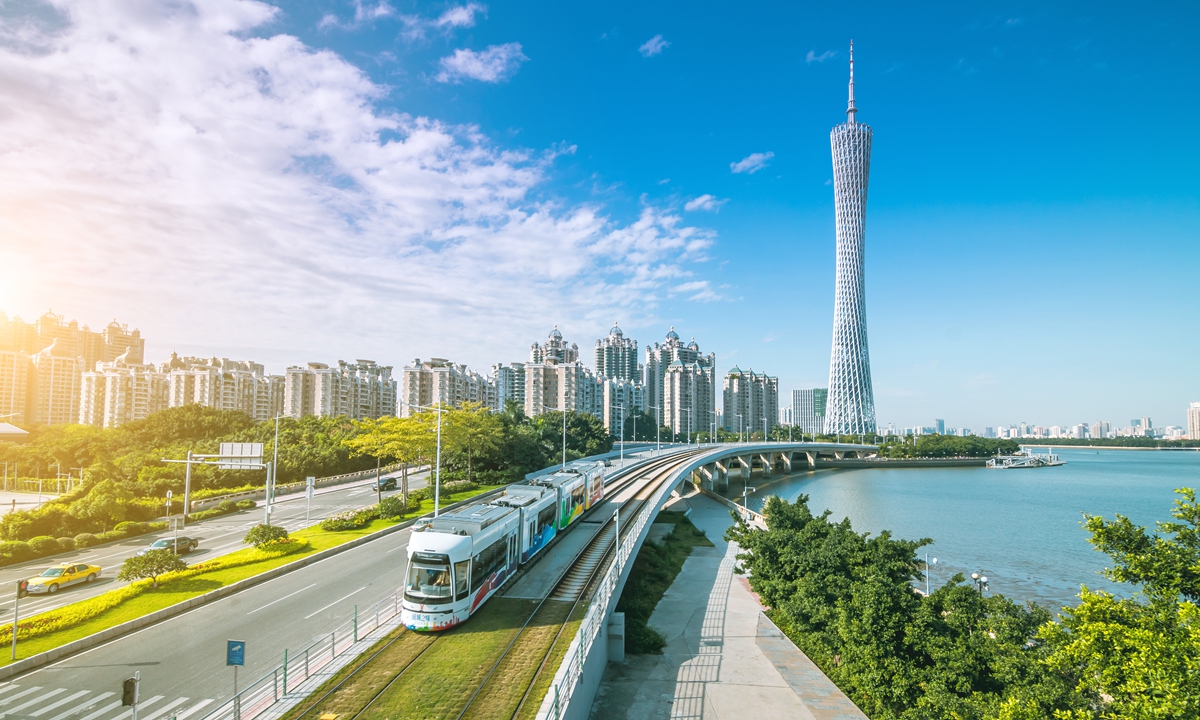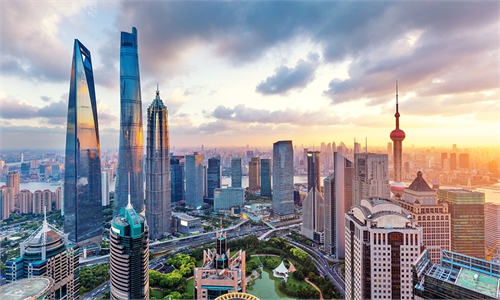
Photo: VCG
Editor's Note:2023 marks the first year to comprehensively implement the spirit of the 20th National Congress of the Communist Party of China (CPC). At the annual Central Economic Work Conference held in Beijing on December 16 and 17, 2022, Xi Jinping, general secretary of the Communist Party of China Central Committee, Chinese president and chairman of the Central Military Commission, emphasized that the Chinese economy enjoys strong resilience, tremendous potential and great vitality. The effects of various policies continue to show, and the overall economic operation is expected to pick up next year. In the New Year, how can China strengthen the confidence in economic work and expand its economy in a stable manner? The Global Times invites scholars to share their views over the issues. This is the first article of the series.
In recent months, international forecasters have begun to predict a gloomy future for the Chinese economy. In a Bloomberg interview in August 2022, Larry Summers likened China today to Japan in 1990 when many people believed that Japan would overtake the US to become the largest economy in the world. Since Japan did not manage to do that, Summers reckoned, it will not be surprising that China will not do so either. In December, a study by the Japan Center for Economic Research expressed the same view. Paul Krugman recently joined the bandwagon in his latest New York Times column. He believed that China's future isn't what it used to be because China faces headwinds in its demography and its heavy reliance on investment, particularly housing investment, is not sustainable.
Summers' analogy was grossly wrong -- China's population is more than four times the population of the US, whereas the Japanese population was barely above one third. It was indeed unrealistic to believe that Japan would overtake the US in total income because that would require Japan to reach three times US' per-capita income. For China? It suffices if the country's per-capita income moves close to one quarter of the American level, a target that is by no means unreachable for China.
Most of the other pessimistic views about China's growth prospects rely on their projections of a low potential growth rate for China's future. For example, the Japan Center for Economic Research simply assumed China's potential growth rate to decline over the years and converge to the US level, that is, 2.2 percent by 2035. With this assumption, it is easy to reach the conclusion that China will never catch up with the US.
China's potential growth rates
Knowing a country's potential growth rates is important to forecast its economic future. But it is a hard thing to estimate a country's future potential growth rates. It is a bit easier to do that for mature economies than for catching-up economies. By the neoclassical growth model proposed by Robert Solow, a good estimate for a mature economy's potential growth rate is its growth rate of total factor productivity (TFP) -- a measure of an economy's overall efficiency improvement, mainly embodied in technological progress and institutional improvements -- plus its population growth rate. It is widely agreed that the potential growth rate of the US economy is about 2.2 percent per annum. For catching-up economies, their potential growth rates depend on their rate of capital accumulation, as well as their rate of TFP growth. With this in mind, one can get a rough estimate of China's current and future potential growth rates.
China's savings are still 45 percent of its national GDP, while its stock of net capital in the production sector is 3.6 times of GDP. Assuming all savings are being converted into capital, then China's capital stock would grow by 12.5 percent per annum. China's capital stock is relatively young; a reasonable annual depreciation rate is 5 percent. As a result, productive capital would grow by 7.5 percent per annum in net terms. Because capital makes up half of the production, this would be translated into 3.75 percent in GDP growth.
There are many debates about China's TFP growth. One thing worth remembering is that most of the TFP measures are derived from the so-called Solow residuals which are highly pro-cyclical. No wonder many researchers have come up with very small or even negative TFP growth rates for China in the last decade when the country's economic growth has substantially slowed down. Even so, the lower bound for the share of TFP growth in China's potential growth rates is 20 percent, and the upper limit can be as high as 40 percent. Using 3.75 percent as the basis, then China's potential growth rates vary from 4.7 percent to 6.3 percent, with the average being 5.5 percent.
In coming years, China's savings rate will decline. In fact, China's savings rate has already declined by 7 percentage points since 2010. The other side of the story is that domestic consumption has increased as a share in GDP. Krugman's assertion that China has kept consumer spending low is simply wrong. China has embarked on a path of rebalancing since 2010. The COVID pandemic has reversed the course a bit and the national savings rate is likely to have increased to 47 percent. But this reversal is unlikely to continue after the pandemic ends.
Taking the declining trend of savings rates between 2010 and 2020 to project China's future savings rates on the basis of 47 percent for now, by 2030 China's savings rate will be 41.4 percent. Assuming that the capital-GDP ratio is still 3.6, but capital depreciation rate increases to 6 percent, then capital accumulation will contribute 2.75 percentage points to China's growth. Still assuming that TFP growth accounts for 20 - 40 percent of overall GDP growth, China's potential growth rate will then reach an average of 4.0 percent by 2030. Between 2023 and 2030, the average potential growth rate will be 5 percent.
With this growth rate, will China be able to catch up with the US in nominal GDP by 2030? The answer depends on the real exchange rate between the dollar and RMB which equals the nominal exchange rate plus the gap of inflation in the two countries. In 2022, the RMB devalued against the dollar by more than 10 percent and the US has had a much higher inflation rate than China's. But this is unlikely to become the norm in the future years. According to the Balassa-Samuelson effect, a country's currency will appreciate against its major trading partners as long as its productivity increases relative to its major trading partners. Studies on historical data show that RMB would appreciate against the dollar by 0.4 percentage points in real terms if China grew 1 percentage point higher than the US. It is unlikely that China will stop its productivity catch-up in the future, so RMB is not going to have real devaluation against the dollar.
The American economy is likely to experience a mild recession in 2023. Inflation in the country has passed the turning point and begun to taper. In contrast, the Chinese economy will recover. As a result, the RMB will resume its path of appreciation against the dollar.
China's GDP is likely to constitute 72 percent of US GDP in 2022. Assuming that the American economy grows by 2.2 percent andthe Chinese economy grows by 5 percent, and the dollar and RMB maintain their current exchange rate in real terms, it is simple to see that China will catch up with the US in 2029.
Short-term issues
However, potential growth is not realized growth. Whether an economy can reach its potential growth rates depends on whether it has enough demand. During the three years of fighting against COVID-19, China relied on investment and export to generate demand. But there is a limit for investment because it faces the law of diminishing marginal returns. Capital formation contributes 2 - 2.5 percentage points of growth at the most. The role of export will drastically decline in the coming years because the whole world is decelerating. So, China has to boost its domestic consumption to generate enough demand.
One uncertainty for domestic consumption is how COVID-19 will evolve. In the most parts of 2022, China was able to contain the spread of the virus, but has paid a heavy price to its economy. Consumption growth has been sluggish and moved into negative territory in recent months. As consumption accounts for more than 65 percent of China's GDP, sluggish consumption growth has become a big drag on GDP growth.
China's new 10 measures against COVID-19 have changed the course of China's COVID policy. Most Chinese cities have lifted their stringent COVID policies. The number of confirmed cases has soared, but the number of severe cases has been low. Most cities will be likely to reach the peak of infection before the Spring Festival (January 22) after which infection will subdue. The Chinese government has announced to treat the COVID virus as a second-category virus. This has eliminated the possibility that China will revert its current COVID policy unless deadly variants come out again. As a result, life will resume normal in most parts of the country in the spring of 2023.
The recently concluded economic conference has sent out encouraging signals for government policy. Fiscal expansion will continue, and monetary policy will be accommodating. The most encouraging development is that the conference named the housing market as one of the drivers of recovery. After a year of decline, the sector will probably resume growth in 2023. That will mean a lot for China's domestic consumption because the sector generates large amounts of consumption through its upstream and downstream linkages.
Adding up all the factors, it is reasonable to envision a revived consumer market in 2023. Before the pandemic, consumption growth was always 7 percent or higher. For China to reach its potential growth of 5.5 percent, though, it is sufficient for consumption to grow by 5.4 percent, a target that is definitely in China's reach in its post-COVID periods.
Economic restructuring sets the stage for a new period of growth
Foreign observers often cite distorted economic structure and aging as two most serious impediments for China's long-term growth. But most of the distortions have been corrected by the restructuring programs over the last decade, and the negative impacts of aging have been exaggerated, at least for the next 10 years.
Before 2010, China relied on export and investment to drive its growth. While most analysts believed that it was not a sustainable growth model, it is worth realizing that it was a natural choice for China at the time. China had abundant human resources and a complete production network by the time when China joined the World Trade Organization (WTO) in 2001. In the meantime, China's domestic market was still relatively small. As a result, export was a natural choice. In the meantime, China's national saving rate began to soar up. Between 2001 and 2010, it increased by 14 percentage points to reach 52 percent of GDP. With this burgeoning savings, it was natural for China to invest heavily in infrastructure and industrial equipment.
The global financial crisis has changed the course of China's growth trajectory. Global demand has decelerated; slower growth of export led to structural adjustment in its economy. First of all, domestic consumption has increased and savings rates have declined. As a result, the share of capital formation in GDP has declined. With consumption accounting for 65 percent of GDP and 75 percent of GDP growth before the pandemic, it is no longer appropriate to call the Chinese economy an investment-driven economy.
Second, the government started a campaign to shed off redundant industrial capacity, particularly in the sectors generating heavy pollution such as coal mining and steel production. Because northern provinces had more coal mines and steel plants, they were hit the most and their income gaps with the southern provinces have become larger since the mid-2010s.
Third, partly because of entrepreneurs' self-consciousness, partly because of the government's promotion, innovation has become the street talk in Chinese cities. China is quickly moving to the world frontiers in middle-level technologies; hidden champions emerge in almost every industry. In some new sectors, China is leading the world. The electric vehicle (EV) industry is a typical example. China is a latecomer in this industry. But within a matter of 10 years, China has emerged as the leader of the global EV industry. In the first 11 months of 2022, China sold more than 6 million EVs, more than 70 percent of the world total. China also leads the world in the solar power industry, producing three fourths of the world solar panel products. China's wind power investment has been half of the world's total in most of the recent years. Thanks to those developments and technological progress in other fields, China is becoming the largest contributor for a cleaner global economy.
Fourth, China's government conducted an overhaul of the country's financial sector through a series of deleveraging efforts. The rise of shadow banking has brought sizable gains to the Chinese economy, but in the meantime it has also created risks to the financial sector. The deleveraging efforts have successfully eliminated those risks. The idea that money can create money is gone and serving the real economy has become the first priority of all financial institutions.
China's economy has shown cycles of growth and restructuring in the reform era. The 1980s was a decade of growth, mostly generated by rural reform. Then in the 1990s, major reforms in the urban areas took place. Those reforms were painful, but cleared the way for China's phenomenal growth in the 2010s. The last decade was another period of restructuring. Although it was less painful than the reforms in the 1990s, it served the same purpose to clear ways for future growth. So, one has reasons to believe that a new period of growth is coming.
The Impacts of Aging Are Exaggerated
Aging is a sure thing in China. But it is debatable how aging will affect China's growth. The conventional views about aging's negative impacts on China's growth do not stand close scrutiny.
The most often cited reason for aging to slow down growth is the decline of the labor force. But this reason has to be qualified by other factors too, particularly AI and automation. In China 2049, the research team of the National School of Development at Peking University estimates that AI and automation will replace more workers than the number of labor brought down by aging in the next three decades. This means that unemployment, or at least structural unemployment, will be a more pressing problem than the lack of workers for China. Indeed, one of the labor market challenges is how to create jobs for the 10 million university graduates produced in each year. At any rate, decline of the labor force will be compensated by the growth in AI and automation.
Another compensating factor is rising education. Younger generations are getting more and better education than older generations. Studies have found that when productivity is measured by education adjusted by the rate of return to education, people in their 20s are twice as productive as people in their 40s and 50s. That is, rising productivity alone can more than compensate for the reduction of labor caused by aging.
Another worry that is often mentioned by people is slower growth of consumption. Things happening in Japan seem to confirm this worry. Despite of negative deposit rates, elderly Japanese continue to save. In this regard, getting old before getting rich in China may help the country postpone the slowdown of consumption growth. Income will still grow and generate consumption. Younger generations are more inclined to bear debts for consumption than their parents. In addition, more than 120 million people will move from the countryside to the city in the next 10 to 15 years. Holding their income constant, urban residents consume more than their rural counterparts.
There are headwinds for China's economy and its growth will slow down as it moves closer to the world technological frontiers. But one should not exaggerate the speed of the slowdown. The structural adjustments in the last 10 years have paved way for a new round of growth. Aging will not become a serious challenge for growth until after 2030 when the main bodies of baby boomers of 1962 - 1976 have retired and their pensions and healthcare become a burden of the economy. But even on that count China will be likely to do a better job than others. China has a large state sector whose capital stock is estimated to have a net value of 60 trillion yuan. The central government has begun to transfer state shares to the national pension fund. Those shares will generate enough dividends to buttress the country's old-age security system.
The author is Liberal Arts Chair Professor, National School of Development, Peking University. opinion@globaltimes.com.cn



